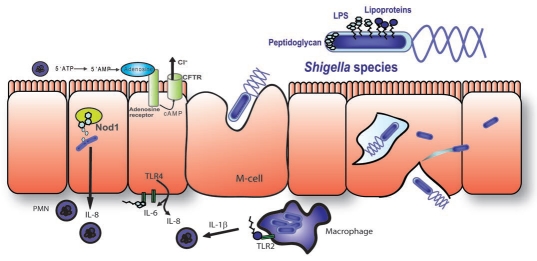Figure 4.
Invasion and inflammation caused by Shigella. Shigella species cross the epithelial barrier through M-cells where they encounter and eliminate macrophages. Binding of lipoprotein to TLR2 results in the production of the chemoattractant IL-1β. After translocation through M-cells LPS can bind to basolateral TLR4 which causes the production of IL-6 and IL-8. This effect is somewhat diminished due to the acetylation of LPS in Shigella. IL-8 is a potent chemoattractant for PMNs and is also produced due to activation of intracellular Nod1 by peptidoglycan. PMNs are the primary destructive force in Shigella infection. PMNs cause Cl− secretion through generation of a precursor to the secretagogue adenosine and can also cause ulceration of the epithelium, which results in a decrease in the absorptive surface but also maximizes permeability and allows easy access of gut flora to the basolateral surface of cells further driving inflammation.

